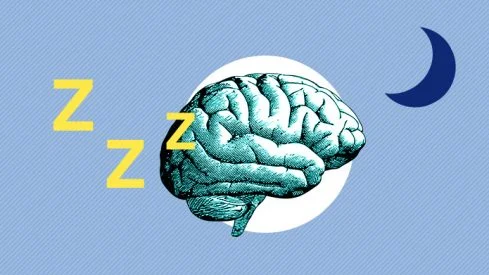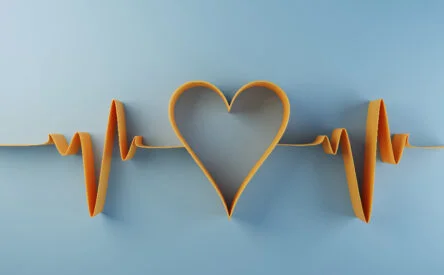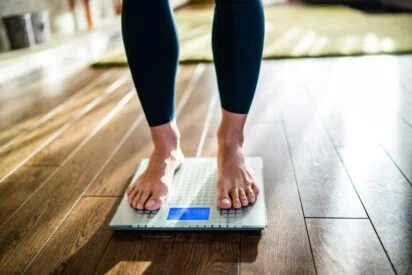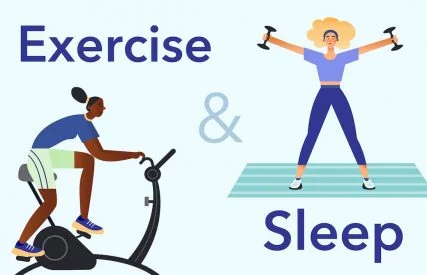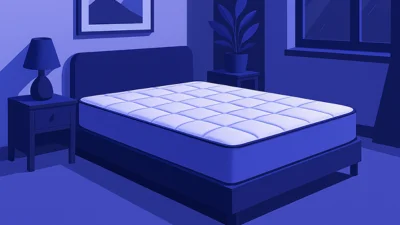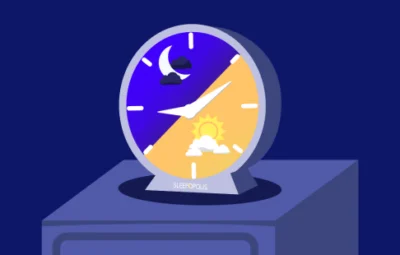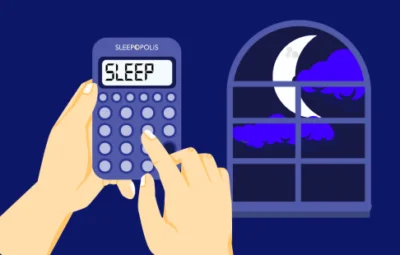
Long Story Short
- Burnout is the result of chronic, unmanaged stress and causes emotional, physical, and cognitive fatigue. (1) (2)
- Over 50 percent of workers experience work-related stress associated with burnout, including emotional exhaustion, irritability, and anger. (3)
- Many people are at risk for burnout, including caregivers, front line workers, parents, healthcare workers, and shift workers. (2)
- Symptoms of burnout are often similar to the causes of burnout. For example, if you’re burnt out from lack of sleep, you’re likely to experience exhaustion as a burnout symptom. (4)
- Sleep deprivation itself can lead to burnout and create an ongoing cycle of insomnia and poor sleep quality as a result. (4)
Everyone feels stressed now and then, but when stress goes on too long, it can sometimes turn into burnout. (5) Burnout can make you feel worn out, defeated, irritable, and can even affect your appetite and how well you sleep. (1) (2) (6) Luckily, it is possible to recover from burnout and get better rest. Read on to learn all about burnout, how it affects sleep, and how you can break the burnout cycle.
Note: The content on Sleepopolis is meant to be informative in nature, but it shouldn’t be taken as medical advice, and it shouldn’t take the place of medical advice and supervision from a trained professional. If you feel you may be suffering from any sleep disorder or medical condition, please see your healthcare provider immediately.
What is Burnout?
Burnout includes physical, emotional, and mental exhaustion caused by ongoing stress. (5) The term “burnout” frequently describes overwork and overwhelm in work settings, but anyone with chronic stress can experience the phenomenon. For example, people caring for chronically ill family members or children at home can also face burnout. (5)
Below, we’ll explain burnout symptoms, compare burnout to stress, and talk about what burnout and sleep do to one another.
Burnout Symptoms
Symptoms of burnout often start out slow and subtle, and can vary depending on the cause. (1) (6) These symptoms can come on gradually and may include: (7)
- Feeling physically or emotionally exhausted
- Headaches
- Problems sleeping
- Becoming cynical
- Isolation from friends and family
- Muscle tension
- Gastrointestinal symptoms like nausea
- Feeling helpless or defeated
You may experience slightly different symptoms from someone else with burnout, but all symptoms center on the three pillars of emotional, physical, and cognitive exhaustion. (1) “The signs [of burnout] can severely affect personal and professional life, making early recognition vital for recovery,” says Joel Frank, PsyD, clinical psychologist and neuropsychologist at Duality Psychological Services. Burnout happens when feeling tired transforms into extreme exhaustion.
Stress vs. Burnout
The key difference between stress and burnout lies in timing: periods of stress are normal, but when stress becomes long-term (chronic), you can wear down. (8)
When you get stressed, your brain activates the “fight or flight” response, raising your heart rate, tensing your muscles, and sharpening your senses. (8) “Stress is a reaction to specific challenges and can motivate individuals — it’s characterized by temporary anxiety and physical symptoms,” says Frank.
“In contrast, burnout is a chronic state of exhaustion resulting from prolonged stress, leading to feelings of detachment and decreased performance,” he tells Sleepopolis. (8) To determine whether you’re dealing with stress or burnout, you can ask yourself these questions: (10) (11)
- Am I feeling constantly exhausted, both physically and mentally, regardless of how much rest I get?
- Am I getting sick more often than I usually do?
- Do I feel detached or emotionally numb, struggling to care about things that once mattered to me?
- Am I increasingly irritable or frustrated, even over small things?
- Have my sleep patterns changed significantly, either sleeping too much or too little?
- Do I feel like my efforts are never enough, no matter how much I achieve or accomplish?
- When I wake up, do I lack energy for a new day?
If you answered “yes” to any of these, you may be experiencing burnout. However, burnout is nuanced and can be difficult to define and diagnose, so be sure to talk over your symptoms with a healthcare provider if you’re not sure or feeling concerned.
Who Experiences Burnout?
While burnout was initially defined in workplace settings, anyone can experience it. From teachers to parents, burnout can affect many groups. (6)
Employee Burnout
Work burnout can make you feel drained at your job, unable to cope, angry, sad, and irritable. Burnout at work may link to a lack of control, overwhelming expectations, conflicts with coworkers, a lack of support, and issues with work-life balance. (12) (13)
Teacher Burnout
Up to 74 percent of teachers go through periods of burnout.
(14) (15) Teacher burnout can stem from extreme demands on their energy and time and from stress brought on by student behavior and working conditions, sometimes leading to anxiety, anger, and emotional withdrawal. (14) (15)
Nurse Burnout
About two in three nurses experience burnout. (16) (17) Nurse burnout can be caused by long hours, inconsistent shift schedules, and staffing shortages, and may make nurses feel more cynical and less compassionate or efficient. (17) (18) (19)
Mom Burnout and Parental Burnout
When parents get burned out, they can feel emotionally distant from their kids and sometimes experience substance addiction and sleeping disorders. Especially in Western cultures, parent burnout may arise from extreme parenting demands (like expensive childcare and busy extracurricular activities) with limited resources. (20)
Empathy Burnout and Compassion Fatigue
Empathy and compassion — understanding and feeling others’ emotions — are normal human experiences. But over time, you may face empathy burnout or compassion fatigue. (21) This type of burnout is common in caregiver roles, whether professional or personal. The constant care of people in difficult situations can lead to burnout if you don’t take time to care for yourself, too. (22)
ADHD Burnout
When you have ADHD, you may already have difficulty planning, organizing, and coping with stress, which can put you at a higher risk for burnout in any workplace or personal circumstances. (23)
Burnout and Sleep
Burnout and sleep often pull each other into a negative cycle in which sleep deprivation feeds the burnout, and those burnout symptoms make it harder to sleep. (4) In one study on nurses, for example, those that slept fewer than seven hours a night had a much higher chance of burnout. (16) In another study, burnout increased the risk of insomnia, a sleep disorder which causes difficulty sleeping for over three months. (24)
But how exactly do sleep and burnout create this cycle? For one, sleep helps you regulate emotion and boost your brain’s thinking ability, but burnout lowers that ability. (25) (26) Poor sleep quality can also exacerbate burnout symptoms like fatigue and irritability, says Frank.
On top of all that, burnout disturbs rapid-eye-movement (REM) sleep, a sleep stage in which certain brain cells (neurons) prepare to assess threats — an important part of the stress response, which plays a role in burnout. (5) (27) (28)
Finally, when you don’t get enough good-quality sleep, your brain can struggle to recover and perform at its peak: sleep deprivation can lead to cognitive impairments (difficulty thinking), trouble regulating your emotions, and difficulty coping with stress, which — over time — can each worsen burnout symptoms. (8) (28) (29) (30) Because of the inherent connection between burnout and sleep, it’s critical to address and manage sleep issues to help treat and prevent burnout.
How to Recover from Burnout
Recovering from burnout takes a multi-faceted approach, but the steps below offer small, simple techniques to start breaking out of burnout. If one increases your stress, skip that for now, and focus on steps that feel right for you.
When to Call a Doctor
Burnout symptoms can sometimes mimic signs of mental or physical conditions, and you can reach out to a healthcare or mental health provider for more help navigating your symptoms. (1)
1. Assess the Situation
The first step in fixing any problem lies in understanding how big it is. “Be mindful of the signs of burnout and acknowledge the need for change to start the recovery process,” says Frank.
Experts have created plenty of tools to assess your burnout level, and Sleepopolis has used these to put together a comprehensive burnout assessment. Some questions you’ll answer include:
- How often do you feel a sense of dread or anxiety about work or personal obligations?
- How often do you experience physical symptoms of stress (e.g., headaches, muscle tension, fatigue)?
- How often do you feel irritable or impatient with others?
- Do you have time to pursue hobbies or interests outside of work?
- Do you find yourself engaging in unhealthy coping mechanisms (e.g., alcohol, overeating, procrastination)?
You can complete the full assessment below and find out where you fall on the burnout spectrum.
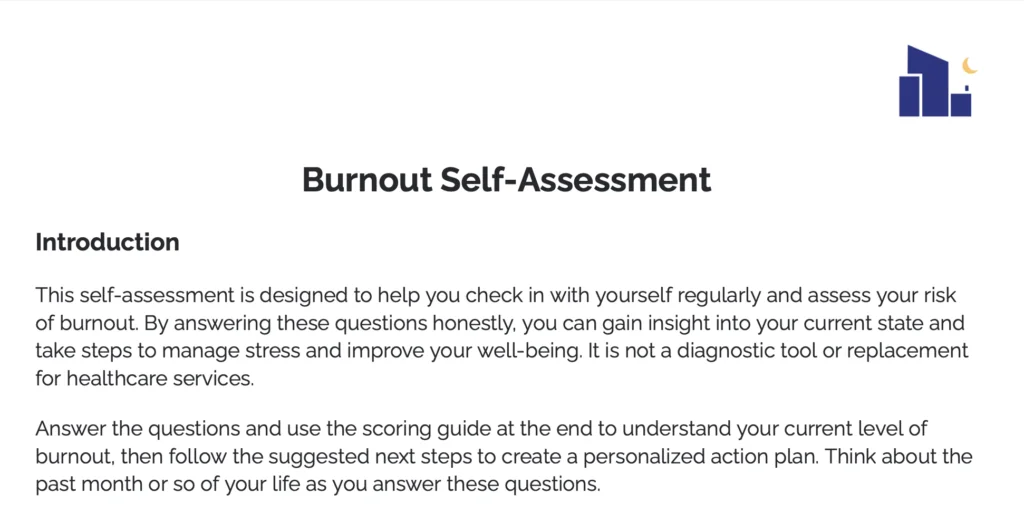
2. Refocus on Rest
Burnout can make you feel like hitting the “reset” button on your life, but drastic life changes can be hard to keep up. Instead of trying to change everything at once, think about starting with sleep.
Sleep recharges your batteries, gives you more energy, and can be increased slowly. (31) For example, if you get six hours of sleep a night, you can start by going to bed 10 minutes earlier and increasing the amount by equally small increments until you reach your goal.
You can also up your sleep game by making your bedroom a bit more comfortable with the perfect mattress, mattress topper, cozy bedding, and a sleep-friendly environment (think cool, dark, and quiet). (32)
3. Examine Your Boundaries
If you say “yes” more than “no,” you may commit to more than you can handle, which can lead to burnout. Our relationships and the demands of everyday life can easily overtake our personal boundaries, but you can reclaim them. (1)
Not sure where boundaries have blurred? Try writing what happens in the day and highlight your biggest energy-suck, which could be a family member, friend, boss, or a situation that keeps recurring.
The crossed boundary could also stem from the sheer volume of tasks you face each day. Once you know what’s stealing your energy and possibly crossing a personal boundary, you can better address it.
When you’re not used to setting and holding personal boundaries, it can feel intimidating to start. But practice makes perfect!
You can start small by saying “no” to activities you’d rather skip or delegating one of your daily tasks to someone else. Over time, you’ll build your boundary-setting muscle and feel able to establish strong boundaries in all areas of life. (33) (34) (35)
4. Make a Self-Care Plan
Self-care involves doing and choosing things that prioritize your mental and physical health. For many, self-care may feel selfish, but it plays a vital role in your health. You may have heard the adage, “You can’t pour from an empty cup,” and highly motivated and busy people may not know their cup emptied a while ago. (36)
Adopting self-care habits doesn’t have to look dramatic — you can make one slight change at a time. Try habit-stacking: adding one new self-care change to your routine, and once that becomes a habit, you can add another. (37)
10 Ways Busy People Can Practice Self-Care:
1. Mindfulness
When you practice mindfulness, you focus your awareness on your senses and feelings in that moment, and you can practice this with several methods, like breathing exercises and avoiding “thinking traps.” (38) (39)
Box Breathing
In one breathing exercise, box breathing, you breathe in for a count of four seconds, hold your breath for four, exhale for four, hold for four, and repeat. This method can melt stress and ease you out of “fight or flight” mode as you combat symptoms of burnout. (40)
2. Intentional Relaxation
Intentional relaxation techniques can do a lot for you, including: (42)
- Slowing your heart rate
- Lowering your blood pressure
- Slowing down your breathing
- Calming down stress hormones (like cortisol)
- Lessening pain
- Helping you focus
- Boosting your energy
You have several options for relaxation. One example, progressive muscle relaxation, involves tensing a muscle group (like those around your scalp), relaxing, tensing the next muscle group (such as your facial muscles), relaxing, and repeating all the way down to your toes. (42) (43)
3. Meditation
Meditation — one form of mindfulness — helps you clear your mind and better handle daily stresses. (38) You can practice meditation through a few different methods. One method, a body scan meditation, involves focusing your attention on each part of your body, one at a time, noticing how they feel and any thoughts connected to them. (38)
In sitting meditation, you can sit in a chair with your feet flat on the ground and your hands relaxed in your lap. Focus on your breathing, and if any thought or sensation interrupts the quiet, acknowledge it and return your focus to your breath. (38)
4. Prioritizing Your Needs
If you’re approaching (or in the middle of) burnout, you may find you don’t have time for meals, snacks, hydration, or relaxation. (36) “Establish limits in personal and professional areas to give yourself time and space to recharge,” says Frank.
By prioritizing your very real needs, you can move out of burnout. If this feels overwhelming, try to focus on one need at a time, like making sure you eat breakfast every day.
5. Journaling Through a Gratitude or Reflection Journal
Research shows practicing gratitude increases happiness and life satisfaction. (44) One way to focus on gratitude is to write what you’re thankful for in a journal. (45)
For example, in the “Three Good Things” exercise, you can practice gratitude by jotting down three good things in your life every day for seven days. When you do this within two hours of bedtime, you can help rewire your brain for more positive thinking. (46)
6. Physical Grounding
Physical grounding (also called earthing) is a therapeutic technique that helps bring a person’s focus back to the present moment, especially when they’re feeling overwhelmed, anxious, or disconnected. It involves using the five senses to reconnect with the physical world around you, essentially “grounding” you in reality when your thoughts or emotions might feel like they’re spinning out of control. In fact, some small studies have shown grounding may decrease stress and inflammation, although research on grounding is still pretty new. (47) (48) (49)
You can practice physical grounding by: (50)
- Placing your feet flat on the ground and focusing on the sensation.
- Holding an object in your hand, noticing its texture and weight.
- Engaging in a physical activity, like stretching or running your hands under cold water.
7. Take Breaks Throughout the Day
When you take short breaks throughout your day, you can practice relaxation, mindfulness, and journaling. Breaks don’t have to be long, and every bit may help. Even taking a quick walk around your office or home counts! (51)
8. Set Limits on Technology Use
Most of the world’s population has an electronic device that connects them to the world. And while some technology can boost brain health, like games and apps that promote memory and brain power, extensive time on screens can also have harmful effects like a shorter attention span, social isolation, and poor sleep. (52) Try to limit your screens if you feel you may be overdoing it.
9. Exercise
All movement helps manage stress, so if you can incorporate some exercise in your day, it can help prevent burnout. (6) Even a simple walk through your neighborhood, around your office, or in nature can clear your mind and shoo away stress. (51)
10. Make a Happy List and Pull From It
What’s a happy list? Well, it’s an ongoing list of things you enjoy. If you need a quick lift in your day, you can consult your happy list and find a little joy there. “To replenish energy, engage in activities that bring joy and relaxation, such as exercise, meditation, or hobbies,” says Frank. Your list can have anything on it that helps you. Here are some examples:
- A dirty chai latte
- A 15-minute stretching session
- The smell of your favorite candle
- Solving a sudoku
- A walk by the river
- A particular album of music
- Your top-choice snack
These aren’t meant to fix everything, but any bit of happiness in your day can help stave off stress. (53)
5. Measure What Matters
Now that you have a plan, it’s nice to know if it’s working. You can keep track of your progress through journaling or with one of many well-being apps available. For example, if your mood is your biggest issue, try out a few simple, easy-to-use mood trackers like Moodfit and MoodTools.
Or, if your energy levels are low, try tracking your sleep with your phone. However you keep track of your progress, remember to celebrate your wins — even if they seem very small.
“Practice patience and self-compassion,” says Frank. “Understand that recovery is a gradual process, and be kind to yourself as you work towards renewed strength and a healthier outlook on life.”
6. Find What Re-Energizes You
Take time to learn your energy-taking and energy-giving activities (and people). Once you identify them, you may be surprised to find your life is full of energy-suckers! (54)
Now, we all have to do things that steal our energy sometimes, but make sure to insert some energy-giving hobbies and people into your schedule. Doing things that bring you joy can offer you a sense of meaning and purpose, and this feeling can help you cope with the stressful, energy-taking parts of life. (54)
7. Think About Future You
What do you want “future you” to look like? As you climb out of burnout, it’s important to plan ahead. Take some time to think about your long-term goals, like optimizing your physical health.
To do this, ask yourself “How do I want to feel in six months? 12 months? Two years?” These long-term goals can help you stay motivated to stick to your plan, boundaries, and the self-care that got you here. (55)
You can also boost motivation by rewarding yourself for goals met. For example, you can say, “If I stay burnout-free for the next six months, I will go away for a fun weekend with a friend.”
8. Make a Prevention Plan
No matter how well you recover from burnout, it’s possible to fall back into old patterns of chronic stress. You can work to prevent future burnout by setting up safeguards in your everyday life. Some steps you might take could include setting goals, seeking support, and doing regular check-ins with yourself. These vital actions can vary from person to person, so feel free to tweak them to fit you best.
The Last Word from Sleepopolis
Burnout describes emotional, physical, and cognitive fatigue caused by long-term stress. (1) (2) Symptoms of burnout can include extreme exhaustion, headaches, difficulty sleeping, muscle tension, and social isolation. (7) Certain groups of people — like teachers, nurses, and parents — experience high levels of burnout, but anyone can undergo this phenomenon.
You can reduce and prevent burnout through lifestyle changes like prioritizing rest and self-care. If you think you may have burnout, try our assessment and recovery steps above. But, it’s always a good idea to keep a healthcare provider in the loop, as burnout may share symptoms with some mental and physical conditions. Between these steps, you can leave burnout behind, get more rest, and live your best life.
Sources
- Khammissa RAG, Nemutandani S, Feller G, Lemmer J, Feller L. Burnout phenomenon: neurophysiological factors, clinical features, and aspects of management. J Int Med Res. 2022;50(9):03000605221106428. doi:10.1177/03000605221106428
- Burn-out an “occupational phenomenon”: International Classification of Diseases. Accessed October 1, 2024. https://www.who.int/news/item/28-05-2019-burn-out-an-occupational-phenomenon-international-classification-of-diseases
- 2023 Work in America Survey: Workplaces as engines of psychological health and well-being. Accessed October 1, 2024. https://www.apa.org/pubs/reports/work-in-america/2023-workplace-health-well-being
- Abera H, Hunt M, Levin JH. Sleep Deprivation, Burnout, and Acute Care Surgery. Curr Trauma Rep. 2023;9(2):40-46. doi:10.1007/s40719-023-00253-9
- Depression: Learn More – What is burnout? – InformedHealth.org – NCBI Bookshelf. Accessed October 1, 2024. https://www.ncbi.nlm.nih.gov/books/NBK279286/#i2125.symptome-5i.whatarethesignsandsy
- Burnout: 5 Signs and What to Do About It. Accessed October 1, 2024. https://health.clevelandclinic.org/signs-of-burnout
- Burnout – Mental Health UK. Accessed October 1, 2024. https://mentalhealth-uk.org/burnout/#section-3
- Stress vs. anxiety vs. burnout: What’s the difference? Accessed October 1, 2024. https://www.counseling.org/publications/counseling-today-magazine/article-archive/article/legacy/stress-vs-anxiety-vs-burnout-whats-the-difference
- Stress | NCCIH. Accessed October 1, 2024. https://www.nccih.nih.gov/health/stress
- Valid and Reliable Survey Instruments to Measure Burnout, Well-Being, and Other Work-Related Dimensions – National Academy of Medicine. Accessed October 1, 2024. https://nam.edu/valid-reliable-survey-instruments-measure-burnout-well-work-related-dimensions/
- Copenhagen Burnout Inventory – CBI. Accessed October 1, 2024. https://nfa.dk/vaerktoejer/spoergeskemaer/spoergeskema-til-maaling-af-udbraendthed-cbi/copenhagen-burnout-inventory-cbi
- Job burnout: How to spot it and take action – Mayo Clinic. Accessed October 1, 2024. https://www.mayoclinic.org/healthy-lifestyle/adult-health/in-depth/burnout/art-20046642
- Employers need to focus on workplace burnout: Here’s why. Accessed October 1, 2024. https://www.apa.org/topics/healthy-workplaces/workplace-burnout
- Agyapong B, Obuobi-Donkor G, Burback L, Wei Y. Stress, Burnout, Anxiety and Depression among Teachers: A Scoping Review. Int J Environ Res Public Health. 2022;19(17):10706. doi:10.3390/ijerph191710706
- Sánchez-Narváez F, Velasco-Orozco JJ, Pérez-Archundia E. Burnout Syndrome and Sleep Quality in Basic Education Teachers in Mexico. Int J Environ Res Public Health. 2023;20(13):6276. doi:10.3390/ijerph20136276
- Saintila J, Soriano-Moreno AN, Ramos-Vera C, Oblitas-Guerrero SM, Calizaya-Milla YE. Association between sleep duration and burnout in healthcare professionals: a cross-sectional survey. Front Public Health. 2024;11. doi:10.3389/fpubh.2023.1268164
- Nurse Burnout: What Is It & How to Prevent It | ANA. Accessed October 1, 2024. https://www.nursingworld.org/content-hub/resources/workplace/what-is-nurse-burnout-how-to-prevent-it/
- Sørengaard TA, Saksvik-Lehouillier I. Associations between burnout symptoms and sleep among workers during the COVID-19 pandemic. Sleep Med. 2022;90:199-203. doi:10.1016/j.sleep.2022.01.022
- Vieira LMSM de A, Mininel VA, Sato T de O. Sleep Quality as a Mediator of Burnout, Stress and Multisite Musculoskeletal Pain in Healthcare Workers: A Longitudinal Study. Healthcare (Basel). 2023;11(18):2476. doi:10.3390/healthcare11182476
- Ren X, Cai Y, Wang J, Chen O. A systematic review of parental burnout and related factors among parents. BMC Public Health. 2024;24:376. doi:10.1186/s12889-024-17829-y
- Empathy – StatPearls – NCBI Bookshelf. Accessed October 1, 2024. https://www.ncbi.nlm.nih.gov/books/NBK549810/
- Compassion Fatigue, Empathy Burnout for Health Care Workers: Which is it? | Mental Health America. Accessed October 1, 2024. https://mhanational.org/compassion-fatigue-empathy-burnout-health-care-workers-which-it
- Turjeman-Levi Y, Itzchakov G, Engel-Yeger B. Executive function deficits mediate the relationship between employees’ ADHD and job burnout. AIMS Public Health. 2024;11(1):294-314. doi:10.3934/publichealth.2024015
- Höglund P, Hakelind C, Nordin M, Nordin S. Risk factors for insomnia and burnout: A longitudinal population-based cohort study. Stress and Health. 2023;39(4):798-812. doi:10.1002/smi.3218
- Koutsimani P, Montgomery A, Masoura E, Panagopoulou E. Burnout and Cognitive Performance. Int J Environ Res Public Health. 2021;18(4):2145. doi:10.3390/ijerph18042145
- Emotion Regulation Strategies, Workload Conditions, and Burnout in Healthcare Residents – PMC. Accessed October 1, 2024. https://www.ncbi.nlm.nih.gov/pmc/articles/PMC7663662/
- Physiology, Sleep Stages – StatPearls – NCBI Bookshelf. Accessed October 14, 2023. https://www.ncbi.nlm.nih.gov/books/NBK526132/
- Khan MA, Al-Jahdali H. The consequences of sleep deprivation on cognitive performance. Neurosciences (Riyadh). 2023;28(2):91-99. doi:10.17712/nsj.2023.2.20220108
- How Sleep Works – Why Is Sleep Important? | NHLBI, NIH. Accessed September 14, 2023. https://www.nhlbi.nih.gov/health/sleep/why-sleep-important
- Alwhaibi M, Al Aloola NA. Associations between Stress, Anxiety, Depression and Sleep Quality among Healthcare Students. Journal of Clinical Medicine. 2023;12(13):4340. doi:10.3390/jcm12134340
- How Sleep Works – How Much Sleep Is Enough? | NHLBI, NIH. Accessed October 21, 2023. https://www.nhlbi.nih.gov/health/sleep/how-much-sleep
- Baranwal N, Yu PK, Siegel NS. Sleep physiology, pathophysiology, and sleep hygiene. Progress in Cardiovascular Diseases. 2023;77:59-69. doi:10.1016/j.pcad.2023.02.005
- 8 Tips on Setting Boundaries for Your Mental Health – DBSA. Accessed October 1, 2024. https://www.dbsalliance.org/support/young-adults/8-tips-on-setting-boundaries-for-your-mental-health/
- How To Set Healthy Boundaries. Accessed October 1, 2024. https://health.clevelandclinic.org/how-to-set-boundaries
- Creating and Maintaining Healthy Boundaries – NAMI Wake County, NC. Accessed October 1, 2024. https://nami-wake.org/creating-and-maintaining-healthy-boundaries/
- What Is Self-Care and Why Is it Important? Accessed October 1, 2024. https://www.ncoa.org/adviser/online-therapy/self-care/
- What Is Habit Stacking? How To Do It. Accessed October 1, 2024. https://health.clevelandclinic.org/habit-stacking
- Mindfulness exercises – Mayo Clinic. Accessed May 10, 2024. https://www.mayoclinic.org/healthy-lifestyle/consumer-health/in-depth/mindfulness-exercises/art-20046356
- Kulchar RJ, Haddad MB. Preventing burnout and substance use disorder among healthcare professionals through breathing exercises, emotion identification, and writing activities. J Interprof Educ Pract. 2022;29:100570. doi:10.1016/j.xjep.2022.100570
- Box Breathing Benefits and Techniques. Accessed October 1, 2024. https://health.clevelandclinic.org/box-breathing-benefits
- Getting to Know Your Thinking Traps | Lyra Health. Accessed October 1, 2024. https://www.lyrahealth.com/blog/getting-to-know-your-thinking-traps/
- Relaxation techniques: Try these steps to lower stress – Mayo Clinic. Accessed October 1, 2024. https://www.mayoclinic.org/healthy-lifestyle/stress-management/in-depth/relaxation-technique/art-20045368
- Pelit-Aksu S, Özkan-Şat S, Yaman-Sözbi̇r Ş, Şentürk-Erenel A. Effect of progressive muscle relaxation exercise on clinical stress and burnout in student nurse interns. Perspectives in Psychiatric Care. 2021;57(3):1095-1102. doi:10.1111/ppc.12662
- Komase Y, Watanabe K, Hori D, et al. Effects of gratitude intervention on mental health and well‐being among workers: A systematic review. J Occup Health. 2021;63(1):e12290. doi:10.1002/1348-9585.12290
- How to Use Journaling as a Coping Tool | NAMI: National Alliance on Mental Illness. Accessed October 1, 2024. https://www.nami.org/person-with-mental-illness/how-to-use-journaling-as-a-coping-tool/
- Leddy M. Thriving, Not Just Surviving: Recognizing Burnout and Simple Tips to Start Feeling Better. J Adv Pract Oncol. 2022;13(3):209-212. doi:10.6004/jadpro.2022.13.3.5
- Chevalier G, Patel S, Weiss L, Chopra D, Mills PJ. The Effects of Grounding (Earthing) on Bodyworkers’ Pain and Overall Quality of Life: A Randomized Controlled Trial. Explore (NY). 2019;15(3):181-190. doi:10.1016/j.explore.2018.10.001
- Sinatra ST, Sinatra DS, Chevalier G. Grounding – The universal anti-inflammatory remedy. Biomed J. 2023;46(1):11-16. doi:10.1016/j.bj.2022.12.002
- Menigoz W, Latz TT, Ely RA, Kamei C, Melvin G, Sinatra D. Integrative and lifestyle medicine strategies should include Earthing (grounding): Review of research evidence and clinical observations. EXPLORE. 2020;16(3):152-160. doi:10.1016/j.explore.2019.10.005
- Grounding or “Earthing” – What Is It, Why Do It & 5 Ways to Try It – St. Jude Wellness Center. Accessed October 1, 2024. https://stjudewellnesscenter.org/grounding-or-earthing-what-is-it-why-do-it-5-ways-to-try-it/
- Exercise and stress: Get moving to manage stress – Mayo Clinic. Accessed October 1, 2024. https://www.mayoclinic.org/healthy-lifestyle/stress-management/in-depth/exercise-and-stress/art-20044469
- Small GW, Lee J, Kaufman A, et al. Brain health consequences of digital technology use. Dialogues Clin Neurosci. 2020;22(2):179-187. doi:10.31887/DCNS.2020.22.2/gsmall
- 3 Tips to Manage Stress | American Heart Association. Accessed October 1, 2024. https://www.heart.org/en/healthy-living/healthy-lifestyle/stress-management/3-tips-to-manage-stress
- Manage Your Energy, Not Your Time. Accessed October 1, 2024. https://hbr.org/2007/10/manage-your-energy-not-your-time
- Goal Setting Techniques: Ways To Effectively Set and Achieve Goals. Accessed October 1, 2024. https://www.nsls.org/goal-setting-techniques
Frank, Joel, PsyD. Personal Interview. September 30, 2024.
